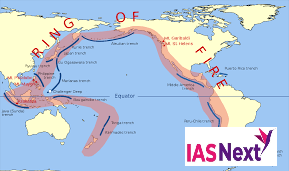CURRENT AFFAIRS
Get the most updated and recent current affair content on Padhaikaro.com
Pacific ring of fire
- IAS NEXT, Lucknow
- 16, Dec 2021

Reference News-
A 7.3-magnitude earthquake struck eastern Indonesia.
- The epicentre was in the Flores Sea, north of East Nusa Tenggara province.
Why Indonesia is vulnerable to earthquakes?
Indonesia sit along the Ring of Fire region, an area where most of the world’s volcanic eruptions occur. The Ring of Fire has seen a large amount of activity in recent days, but Indonesia has been hit hard due to its position on a large grid of tectonic plates.
Indonesia is at the meeting point of three major continental plates – the Pacific, the Eurasian and the Indo-Australian plates – and the much smaller Philippine plate. As a result, several volcanoes on the Indonesian islands are prone to erupting. Indonesia is home to roughly 400 volcanoes, out of which 127 are currently active, accounting for about a third of the world’s active volcanoes.
What is the Ring of Fire?
The Ring of Fire is a Pacific region home to over 450 volcanoes, including three of the world’s four most active volcanoes – Mount St. Helens in the USA, Mount Fuji in Japan and Mount Pinatubo in the Philippines. It is also sometimes called the circum-Pacific belt.
- Around 90% of the world’s earthquakes occur in the Ring of Fire, and 80% of the world’s largest earthquakes.
Location:
- It stretches along the Pacific Ocean coastlines, where the Pacific Plate grinds against other, smaller tectonic plates that form the Earth’s crust – such as the Philippine Sea plate and the Cocos and Nazca Plates that line the edge of the Pacific Ocean.
- The 40,000 kilometre horse-shoe-shaped ring loops from New Zealand to Chile, passing through the coasts of Asia and the Americas on the way.
Risk:
The people most at risk from activity in the Ring of Fire are in the US west coast, Chile, Japan and island nations including the Solomon Islands. These areas are most at risk because they lie on so-called subduction zones – which are boundaries that mark the collision between two of the planet’s tectonic plates.
How was the Ring of Fire formed?
The Ring of Fire is the result from subduction of oceanic tectonic plates beneath lighter continental plates. The area where these tectonic plates meet is called a subduction zone.
Why does the Ring of Fire trigger earthquakes?
- The world’s deepest earthquakes happen in subduction zone areas as tectonic plates scrape against each other – and the Ring of Fire has the world’s biggest concentration of subduction zones.
- As energy is released from the earth’s molten core, it forces tectonic plates to move and they crash up against each other, causing friction. The friction causes a build-up of energy and when this energy is finally released it causes an earthquake. If this happens at sea it can cause devastating tsunamis.
- Tectonic plates usually only move on average a few centimetres each year, but when an earthquake strikes, they speed up massively and can move at several metres per second.